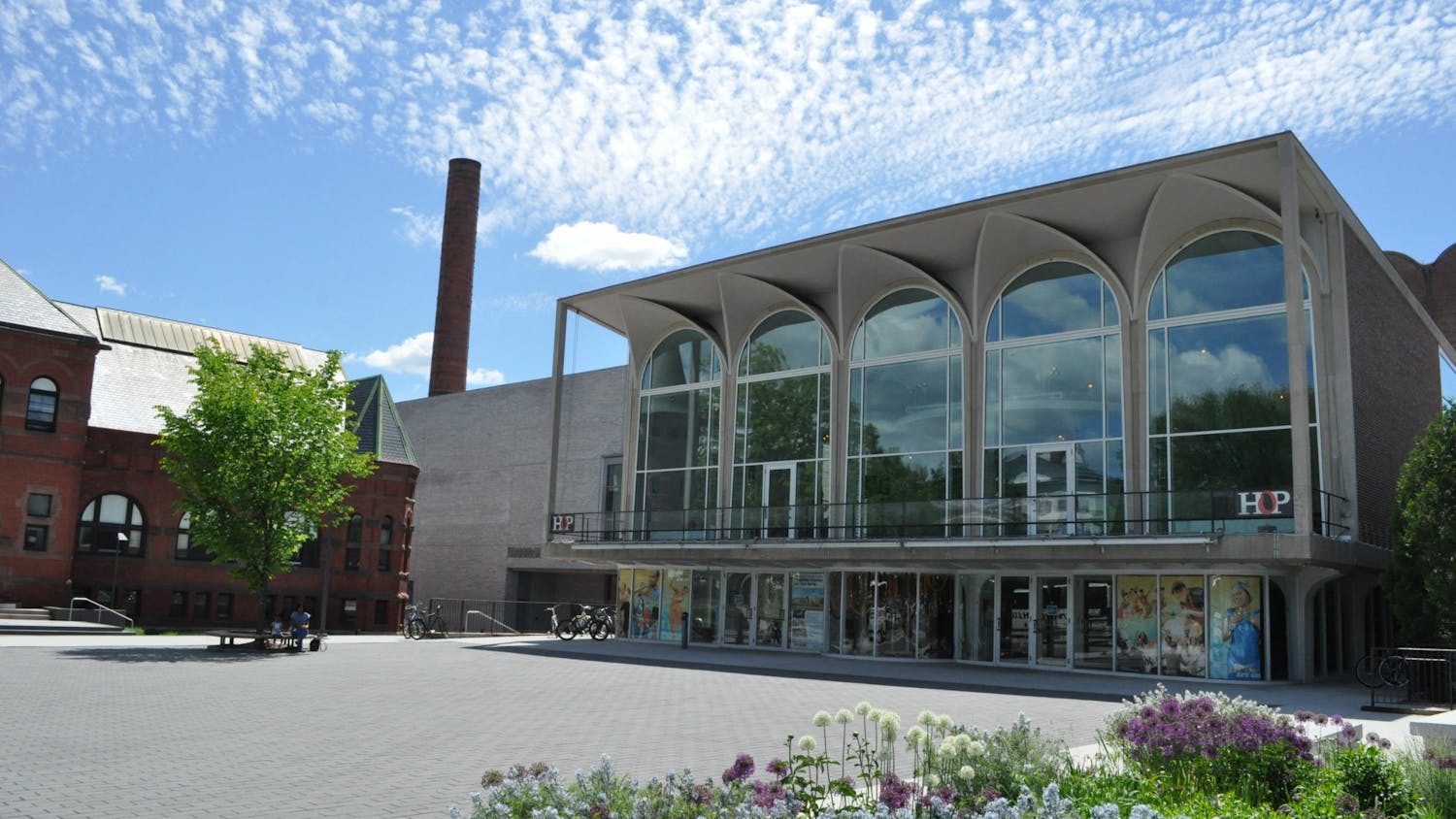On Sept. 27, the Hood Museum of Art hosted artist Enrique Martínez Celaya to discuss his latest exhibition, “The Grief of Almost.” The exhibition, which includes four large-scale paintings and one monumental sculpture, explores humanity’s drive for self-realization and introspection, according to the Hood website.
Approximately 100 people attended the event, which was held in the Hood auditorium. Following Martínez Celaya’s presentation, Hood director John Stomberg moderated a brief Q&A session with the artist.
The art in “The Grief of Almost” — displayed at the Hood — took nearly a decade to make, according to the Hood website. The featured pieces allude to the poetry of Robert Frost, who briefly enrolled at Dartmouth in the fall of 1892. Depictions of apple trees, fire and ice and the night sky recur throughout the exhibition.
During the lecture, Martínez Celaya clarified that, while much of the imagery in the exhibition is related to Frost, he did not intend to tell Frost’s story or claim a “deep understanding” of his life.
“What is not known and what is unknowable are critical forces in this world,” Martínez Celaya said in the lecture. “‘The Grief of Almost’ is concerned with these unknowns. It is also more about my own myths from projections [than] it is about Frost, about my own hopes and concerns as an artist and a father, about art, time, memory and the search for being against the reality and impermanence.”
At the same time, Frost’s life has consistently resonated with him, Martínez Celaya said.
In 2015, Martínez Celaya came to Dartmouth as a Montgomery Fellow — a program that invites leaders from both academic and non-academic spheres to reside in the Montgomery House in Hanover for varying periods . According to Martínez Celaya, he explored the poet’s archives in Rauner Library and visited his former home in Derry, N.H. throughout his time in Hanover. During his stay, Martínez Celaya was particularly struck by Frost’s artistic exploration of the loss of his son, Carol Frost. The artist ultimately drew from that stage of Frost’s life to explore themes of sorrow and resilience in his own work, he explained. As the project that would become “The Grief of Almost” developed, representations of Frost’s life and family history thus became part of the exhibition, Martínez Celaya said.
According to Martínez Celaya, “The Emissary” — the monumental sculpture in the exhibition — represents the intersection of loss and potential renewal. The sculpture depicts a starry black plane descending into space, carrying a dead apple tree. This tree, while devoid of leaves, invites the possibility of redemption through audience engagement: visitors of the exhibit are encouraged to write down poems and responses to the exhibition, which museum staff will attach to the tree’s branches. The attached papers, which will be folded for privacy, are meant to act as new “leaves,” symbolically reviving and nurturing the uprooted tree, according to instructions posted in the gallery.
Curatorial Affairs associate director Jami Powell explained that personal interpretation is an important component of the exhibition. She noted that the exhibition is designed to encourage viewers to engage with the artwork on a more personal level, allowing them to draw their own conclusions about its meaning.
Unlike other exhibitions on display at the Hood, “The Grief of Almost” does not use traditional labels or explanatory plaques to guide the viewer through the meaning of any of the pieces, according to the Hood website. Instead, visitors are free to form their own interpretations without the influence of predetermined explanations.
“I think one of the things that I appreciate is that it leaves space for ambiguity and for people to grapple with the work on their own terms and from their own experiences of understanding, rather than me as a curator telling them what they should think about the work,” Powell said.
Powell added that she has observed visitors returning to the exhibition multiple times — and that with each visit, they tend to “dig a bit deeper” in their consideration of the works.
In an interview, Martínez Celaya echoed that he did not want to tell viewers what to think about the exhibition, but rather encourage an opportunity for resonance and introspection. He aimed to create a space where personal reflection could occur naturally, he said.
“I would want somebody to be moved — to be transformed in some manner by the experience, even if they don’t know why they’re having that experience,” he explained.
Martínez Celaya added that he is ultimately not interested in following artistic trends. Rather, he focuses on depicting existential topics through seemingly simple mediums — blending accessibility with what he called “profound existential and personal explorations.”
Christopher Wailoo ’82, a Hood board member present at the lecture, said Martínez Celaya’s exhibition was important because it put the question of ethics in art at the forefront. Wailoo said he hopes the dialogue sparked by the lecture will influence visitors’ engagement with the piece, especially by encouraging reflection.
“There are artists who do great work, but they’re not really ethical people,” Waloo said. “[Martínez Celaya is] in this other space, asking, ‘What is the kind of work I want to do?’ And it’s important, apart from being an artist, that this is his commentary on being a good person in the world. Engaging with the work in that view with an artist who’s thinking that way — I hope this [resonates with] someone in the Class of 2028.”
“The Grief of Almost” will be on display at the Hood until April 6, 2025.




